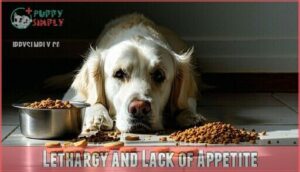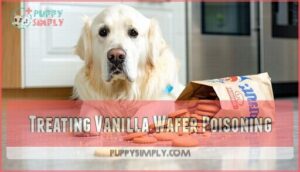This site is supported by our readers. We may earn a commission, at no cost to you, if you purchase through links.

Plus, most dogs don’t know when to stop, and too many sugary treats might leave you cleaning up a mess—if you catch my drift. If your furry friend has already snagged one, don’t panic, but keep an eye out for symptoms like vomiting or lethargy.
Instead, try offering dog-friendly alternatives, like plain apple slices or homemade treats. Your dog will thank you for providing a healthy option, and you can avoid dealing with the potential consequences of feeding them sugary snacks, which can be a real mess.
Table Of Contents
- Key Takeaways
- Dogs Eating Vanilla Wafers
- Can Dogs Eat Vanilla Wafers
- Health Risks for Dogs
- Symptoms of Vanilla Wafer Consumption
- Immediate Actions for Dog Owners
- Safe Alternatives to Vanilla Wafers
- Dietary Recommendations for Dogs
- Expert Opinions on Vanilla Wafers
- Treating Vanilla Wafer Poisoning
- Making Dog-Friendly Vanilla Wafers
- Frequently Asked Questions (FAQs)
- Is it safe for dogs to eat vanilla wafer cookies?
- Can my dog eat vanilla Oreo cookies?
- Can dogs have vanilla in cookies?
- Are there any restrictions on how much Vanilla Wafers I can feed my dog?
- How can I tell if my dog has consumed too much Vanilla Wafers?
- What are the effects of excessive vanilla ingestion?
- Are there safer alternatives to store-bought dog treats?
- How does alcohol in vanilla impact dogs?
- Are organic vanilla wafers better for dogs?
- Conclusion
Key Takeaways
- Vanilla wafers aren’t toxic, but their high sugar, artificial flavors, and fats can harm your dog’s health over time.
- Watch for vomiting, diarrhea, or lethargy if your dog eats vanilla wafers, and consult a vet if symptoms worsen.
- Safer alternatives like plain apple slices, carrots, or homemade dog treats are healthier and better for your furry friend.
- Always check ingredient labels for harmful additives like xylitol or alcohol-based extracts, as these can be dangerous for dogs.
Dogs Eating Vanilla Wafers
You might be tempted to share a vanilla wafer with your dog, but it’s important to know the risks first.
While these cookies aren’t toxic, their sugar and artificial ingredients can cause health issues over time.
Toxic Ingredients in Vanilla Wafers
Vanilla wafers contain toxic ingredients for dogs, like artificial vanilla, which often includes alcohol, and xylitol, a dangerous sweetener.
Some brands may also have macadamia nuts, while sodium bicarbonate can upset your pup’s stomach.
Always check vanilla wafer ingredients since artificial additives and harmful chemicals can cause health problems.
Play it safe—skip sharing these cookies!
Sugar Content in Vanilla Wafers
Ever wondered why vanilla wafers aren’t the best choice for your pup?
The high sugar content can spike blood sugar, leading to long-term effects like diabetes or canine obesity.
Dogs don’t process sugar well, and hidden sugars in wafers make it harder to gauge safe amounts.
Stick to dog-friendly treats to keep your furry friend healthy!
Artificial Flavors and Preservatives
It’s not just sugar—vanilla wafers often contain artificial ingredients, preservatives, and chemical additives that can harm your dog.
Flavoring toxicity is a big concern, especially with artificial sweeteners or toxic ingredients like xylitol.
Always check ingredient labels before sharing.
Preservative risks aren’t worth it when safer treats exist.
Keep your pup’s snacks simple and dog-friendly to avoid dog health concerns.
Can Dogs Eat Vanilla Wafers
Are vanilla wafers safe for dogs? Not exactly. While they’re not toxic, they’re far from a healthy choice.
These sugary snacks can lead to long-term effects like weight gain and dental issues if given often. Dogs eat vanilla wafers without immediate problems sometimes, but the high sugar content, artificial flavors, and lack of nutrition make them a poor treat.
Portion control is critical—one wafer mightn’t harm your dog, but more could upset their stomach or contribute to bad habits. Excessive consumption can lead to weight gain and health issues, similar to the risks associated with waffles.
A vet consultation is always a good idea before introducing questionable snacks. Instead, explore wafer alternatives like plain biscuits or safe vanilla dog treats. Your pup’s health is worth the extra effort, even when they beg with those big puppy eyes!
Health Risks for Dogs
Feeding your dog vanilla wafers might seem harmless, but it can lead to some health problems you’ll want to avoid.
Sharing vanilla wafers with your dog might seem harmless, but their sugary ingredients can lead to unexpected health issues over time.
From upset stomachs to long-term risks like obesity and dental issues, these sugary treats aren’t a safe choice for your furry friend.
Vomiting and Diarrhea
If dogs eat vanilla wafers, vomiting and diarrhea are common.
While these symptoms usually fade, they can cause dehydration risks.
Watch for signs like lethargy or weakness—symptom severity matters!
Here’s what you can do:
- Offer small amounts of water to avoid electrolyte imbalance.
- Stick to bland foods for dietary management.
- Seek veterinary diagnosis if symptoms worsen.
Weight Gain and Obesity
Too many vanilla wafers can add unnecessary calories to your dog’s diet, creating a calorie surplus that leads to weight gain.
Obesity in dogs isn’t just about looks—poor portion control and lack of exercise worsen health issues.
Breed predisposition and metabolic rate also play a role, so keeping cookies like these away guarantees better dog health.
Balance is everything, and it is crucial to maintain it to prevent health issues, therefore, keeping cookies away is a good start.
Dental Issues and Pancreatitis
Let’s face it, vanilla wafers might seem harmless, but they pack a sugary punch that’s tough on dog teeth.
Poor dental hygiene often snowballs into issues like decay and, worse, pain.
The cookies’ fat content also adds to pancreatitis causes, a serious condition hurting digestion.
Preventative measures like swapping high-sugar treats for healthier dog-friendly options can protect overall canine nutrition.
Symptoms of Vanilla Wafer Consumption
If your dog sneaks a vanilla wafer, you might notice mild symptoms like vomiting, diarrhea, or lethargy.
These signs are usually temporary, but it’s important to keep an eye on your pup to verify they’re feeling better soon.
Mild Vomiting and Diarrhea
An upset stomach is a common reaction when dogs eat vanilla wafers, often causing mild vomiting or diarrhea.
These symptoms usually don’t last long, but they can be uncomfortable.
Watch for:
- Gastroenteritis signs like loose stools or nausea.
- Severity increasing if larger amounts are eaten.
- Causes related to sugar or fats in wafers.
- Treatment by offering water and light meals.
Increased Urination and Depression
Increased urination, or polydipsia, might hint at behavioral changes or serious issues like kidney function problems or diabetes in dogs.
Vanilla wafers for dogs aren’t a safe option, as their high sugar content can trigger electrolyte imbalance and other underlying causes. Watch closely for signs like depression.
| Symptom | Possible Cause | Risk Level | Action Needed |
|---|---|---|---|
| Excessive Thirst | Kidney Issues | Moderate | Provide water, monitor |
| Frequent Urination | Diabetes in Dogs | High | Contact veterinarian |
| Fatigue or Depression | Electrolyte Imbalance | Low | Observe closely |
| Lethargy and Apathy | Behavioral Changes | Varies | Track over time |
Lethargy and Lack of Appetite
Lethargy and lack of appetite can signal your dog isn’t feeling great after eating vanilla wafers. Pay attention to their energy and eating habits.
- Underlying Causes: High sugar and questionable ingredients can strain digestion.
- Severity Levels: Mild lethargy usually improves within hours; severe symptoms need vet care.
- Hydration Importance: Encourage water intake—it supports energy restoration and recovery.
Consult a veterinarian for any worsening dog symptoms.
Immediate Actions for Dog Owners
If your dog sneaks a vanilla wafer, don’t panic—stay calm and take quick action.
Check for symptoms, remove any remaining cookies or wrappers, and keep an eye on your pup’s behavior, to ensure you are taking the right steps in case of an emergency.
Monitoring Dog’s Behavior
After sneaking a vanilla wafer, keep a close eye on your dog’s behavior. Watch for symptom progression like wobbliness, lethargy, or changes in appetite and activity levels.
Behavioral changes, such as unusual quietness or restlessness, might signal dog symptoms from ingestion. Use this table to guide your Post-Consumption Watch:
| Symptom | Severity | Vet Needed? | Action to Take |
|---|---|---|---|
| Mild diarrhea | Low | No | Monitor closely |
| Vomiting | Medium | Maybe | Limit food, observe |
| Lethargy | High | Yes | Contact the vet |
| Wobbliness | High | Yes | Seek veterinary help |
Always trust your gut—better safe than sorry, and remember to seek veterinary help if you notice any severe symptoms like lethargy.
Removing Vanilla Wafers and Wrappers
After spotting your dog munching on vanilla wafers, act fast to prevent further consumption.
Remove any remaining cookies and wrappers—they’re not just trash, but potential hazards. Like fortune cookies, vanilla wafers offer no nutritional benefits.
Keep things safe with these tips:
- Dispose securely: Use pet-proof trash cans to avoid accidental ingestion.
- Check for wrappers: Dogs may eat them too, causing digestive troubles.
- Prevent access: Store wafers out of reach, ensuring their safety.
Consulting a Veterinarian
If your dog eats vanilla wafers, especially in larger amounts, contacting the vet is wise.
Veterinarian advice guarantees your dog stays safe from risks like sugar toxicity or potential lactose intolerance symptoms.
Share details about the wafers and your dog’s size or health. A quick call can provide dietary guidance, product safety tips, and recommendations for exercise or treat introduction, ensuring a safe and healthy approach to handling potential lactose intolerance.
Safe Alternatives to Vanilla Wafers
It’s tempting to share treats, but vanilla wafers aren’t the best choice for your pup.
Instead, you can offer healthier, dog-friendly alternatives that are just as tasty and much safer.
Dog-Friendly Vanilla Cakes and Treats
If your pup has a sweet tooth, dog-friendly vanilla cakes and treats can keep them happy and healthy.
Dog-friendly vanilla cakes and treats are a sweet way to keep your pup happy while prioritizing their health and safety.
Specialty bakeries and dog treat recipes use safe ingredients like peanut butter or whole brown rice. Homemade treats are fun to whip up, and options like vanilla yogurt icing or pup-friendly ice cream make them irresistible.
Many owners opt for a dog vanilla cake for their pet’s special day.
- Homemade recipes for tasty, dog-safe treats
- Vanilla yogurt icing adds flavor without harm
- Pup-friendly ice cream is perfect for celebrations
Plain Cookies and Biscuits
If you’re skipping vanilla wafers, plain cookies or biscuits can be a safe option for dogs—just keep it simple.
Look for recipes or brands using safe ingredients, avoiding artificial flavors, sugar, or toxic ingredients.
Homemade recipes let you control the baking methods and nutritional value. Consider offering your dog plain dog biscuits as a simple treat.
Remember, portion control is key; even safer treats should stay an occasional indulgence.
Fruits and Homemade Treats
If plain cookies aren’t your thing, safe fruits like apples (without seeds) or bananas make fantastic healthy dog snacks.
For homemade dog treats, try easy baking alternatives with safe cookie ingredients like peanut butter and oats.
Portion control matters, so go small, and exploring dog treat alternatives with simple treat ingredients keeps tails wagging without the sugar overload, which is why homemade dog treats are a great option.
Dietary Recommendations for Dogs
Providing your dog with a balanced, nutritious diet is one of the best ways to keep them healthy and happy.
Stick to vet-approved foods, offer light meals when needed, and include gut-friendly options like plain yogurt in small amounts.
Light Meals and Small Portions
After snacking on vanilla wafers, offer your dog light meals in small portions.
Opt for boiled chicken and rice, small fish portions, or egg servings to settle their stomach. Yogurt dosage, like a teaspoon or two, can help with digestion.
Spread meal frequency throughout the day to avoid overwhelming their tummy. Skip the cookies; focus on dog safety first.
Reintroducing Normal Diet
After offering light meals, start gradually reintroducing your dog’s normal diet.
Portion control is key—small amounts help guarantee their stomach adjusts smoothly.
Watch for signs of food allergies or sensitivity, like itchiness or discomfort.
Healthy fats enhance immune and gut health, so be sure to incorporate them into your dog’s diet.
Keep hydration important by providing fresh water, as it aids digestion and overall health.
Avoid vanilla wafers; stick with balanced dog food and nutritious dog treats.
Live Yogurt for Gut Health
If your dog’s tummy needs care, live yogurt can be a gentle helper.
Packed with probiotic strains, it helps balance gut bacteria and soothes the intestinal tract.
Start small, watching for lactose concerns, as not every pup tolerates it well.
For homemade yogurt recipes, stick to plain, unsweetened options to match your dog’s dietary needs and boost dog nutrition effectively, using live yogurt.
Expert Opinions on Vanilla Wafers
Experts agree that vanilla wafers aren’t toxic to dogs, but they’re far from the best snack option.
With their high sugar content and artificial ingredients, it’s better to stick to treats specifically made for pets.
Avoiding High-Sugar Treats
High sugar content in vanilla wafers isn’t ideal for dogs.
Instead, opt for sugar-free alternatives like fruits or Healthy Snacks with natural sweeteners.
Portion control is critical—overindulging can harm your furry friend’s health and dog diet.
Reading labels helps you avoid sneaky sugars in dog treats.
Remember, what’s sweet for you might sour their health, and portion control is essential to maintain their well-being.
Checking Ingredients for Harmful Additives
Always check vanilla wafers ingredients for hidden toxins to keep your furry friend safe.
Watch for these culprits:
- Xylitol dangers – Even small amounts harm dogs.
- Artificial sweeteners – Toxic ingredients dogs can’t handle.
- Nut allergies – Avoid macadamias.
- Preservative risks – Harmful chemicals lurk silently.
- Artificial vanilla – Leads to serious dog toxicity symptoms.
Stay vigilant, prevent pet toxicity risks!
Treating Vanilla Wafer Poisoning
If your dog gets into vanilla wafers, don’t panic—acting calmly and quickly can make all the difference.
Knowing the symptoms to watch for and when to call your vet will help keep your furry friend safe.
Symptoms and Treatment
Spotting dog toxicity symptoms like vomiting, diarrhea, or behavior changes after dog ingestion of vanilla wafers is important.
Abdominal bleeding and sudden onset symptoms call for Veterinary Consultation. Monitor Symptoms closely, offer Supportive Care with light meals or water, and try Home Remedies like bland foods.
Preventative Measures, like keeping wafers out of reach, can avoid future issues.
| Symptom | Action Needed | Severity Level | Treatment Option |
|---|---|---|---|
| Vomiting/Diarrhea | Monitor Symptoms | Mild | Light, bland meals |
| Lethargy | Veterinary Consultation | Moderate | Supportive Care |
| Abdominal Bleeding | Urgent Vet Visit | Severe | Medical Intervention |
| Appetite Loss | Observe | Low to Moderate | Homemade bland treats |
Veterinary Intervention and Care
If your pup has eaten too many vanilla wafers or other potentially harmful ingredients, an emergency vet visit might be necessary.
Veterinary consultation guarantees your dog gets proper care, including:
- Toxin neutralization for dangerous additives.
- Supportive care like hydration for symptom severity.
- Monitoring for long-term effects of pet toxicity.
- Customized plans for recovery post-ingestion.
Even seemingly harmless treats can contain toxic levels of theobromine, requiring immediate attention.
Quick action reduces pet emergency risks!
Prevention and Precautions
If your dog’s health is your top priority, prevention is your best weapon.
Store vanilla wafers safely out of reach, read labels for hazardous ingredients, and avoid accidental feeding with portion control.
Stay mindful of pet poisoning risks and dog health risks by considering your dog’s specific dietary needs.
When in doubt, seek a veterinary consultation for peace of mind.
Making Dog-Friendly Vanilla Wafers
If you want to treat your dog to something special, making dog-friendly vanilla wafers is a safe and fun option.
By using simple, healthy ingredients, you can whip up a batch that your pup will love without worrying about harmful additives, making it a fun option.
Ingredients and Recipes
Making dog-friendly vanilla wafers is simple with safe ingredients. Swap regular sugar for a touch of honey, ditch artificial vanilla for natural substitutes, and use unbleached flour.
Recipe modifications, like lowering fat content, help create healthier dog treats. Baking alternatives, such as plain applesauce, make fantastic additions.
You can even find specialty dog products online. Treat preparation becomes a breeze, creating delicious dog treats recipes perfect for your furry friend, with the help of natural substitutes.
Safe and Healthy Alternatives
If you’re looking for safer alternatives, there are plenty of options your dog will enjoy!
- Try vanilla yogurt or pup-friendly ice cream with natural flavors.
- Whip up homemade treat recipes featuring safe ingredients like peanut butter or oats.
- Offer fresh fruit options like apples, bananas, or blueberries.
These dog-friendly treats balance health and happiness!
Tips for Dog Owners and Bakers
Before baking, focus on safe ingredients. Avoid sugar, artificial flavors, and risky vanilla extracts.
Ingredient sourcing is key—use dog-friendly options like unsweetened applesauce or peanut butter. Recipe adjustments guarantee treats fit your pup’s needs.
Stick to treat moderation, and always consider vet consultation. Are vanilla wafers safe? Not store-bought ones, but homemade dog treats guarantee safety and tail wags, providing a healthy alternative for your pet.
Frequently Asked Questions (FAQs)
Is it safe for dogs to eat vanilla wafer cookies?
It’s not toxic, but vanilla wafers aren’t great for dogs.
The high sugar, artificial flavors, and potential alcohol traces can cause upset tummies or worse.
Stick with dog-safe treats to keep tails wagging!
Can my dog eat vanilla Oreo cookies?
Dogs shouldn’t eat vanilla Oreo cookies.
They’re loaded with sugar, artificial flavors, and potentially harmful ingredients like chocolate traces.
Stick to dog-safe treats instead—your furry friend’s tummy (and vet bills) will thank you!
Can dogs have vanilla in cookies?
Imagine this: vanilla cookies might smell amazing, but they’re not the best for your pup.
While vanilla itself isn’t harmful, the sugar, artificial flavors, and possible toxic ingredients in cookies make them unsafe.
Choose healthier treats!
Are there any restrictions on how much Vanilla Wafers I can feed my dog?
You should limit vanilla wafers to an absolute minimum—one or two occasionally, if at all.
The high sugar, fats, and artificial ingredients can harm your dog’s health over time, causing obesity, diabetes, or even pancreatitis.
How can I tell if my dog has consumed too much Vanilla Wafers?
Watch for signs like vomiting, diarrhea, lethargy, or increased thirst.
If they ate a lot, symptoms may worsen.
Notice unusual behaviors? Reach out to your vet—it’s better to be safe than sorry!
What are the effects of excessive vanilla ingestion?
Too much vanilla, especially with alcohol-based extracts, can upset your dog’s stomach, causing vomiting, diarrhea, or lethargy.
In severe cases, it may damage organs or become dangerous.
Always check labels and consult your vet!
Are there safer alternatives to store-bought dog treats?
Think of treats as love wrapped in sweetness.
Opt for natural alternatives like apple slices, carrot sticks, or homemade peanut butter biscuits.
These options keep your furry friend happy, healthy, and tail-waggingly safe!
How does alcohol in vanilla impact dogs?
Alcohol in vanilla extract is harmful to dogs because their bodies can’t process it like humans do.
Even small amounts may cause weakness, vomiting, or worse, so it’s best to skip anything alcohol-based.
Are organic vanilla wafers better for dogs?
Organic vanilla wafers might skip artificial additives, but they’re still packed with sugar, which isn’t great for dogs.
A nibble won’t hurt, but healthier, dog-specific treats are way better for their overall well-being.
Conclusion
Think of your dog’s health as a recipe—you want only the finest ingredients for a long, happy life.
While the occasional vanilla wafer cookie mightn’t be poisonous, it’s far from a healthy choice.
The sugar, artificial flavors, and fats can lead to vomiting, weight gain, or worse.
Instead, stick to dog-friendly snacks like plain apple slices or homemade treats.
Keep your pup’s diet clean and wholesome, and you’ll both avoid unnecessary messes and vet visits.
- https://articles.hepper.com/can-dogs-eat-vanilla-wafers/
- https://www.justanswer.com/dog-health/dy1y3-just-home-dog-ate-box-vanilla-wafers.html
- https://www.quora.com/Is-it-safe-for-dogs-to-eat-vanilla-ice-cream-or-other-types-of-ice-cream
- https://bondvet.com/c/edgewater-animal-hospital
- https://www.petmd.com/dog/conditions/endocrine/c_dg_high_blood_sugar




















